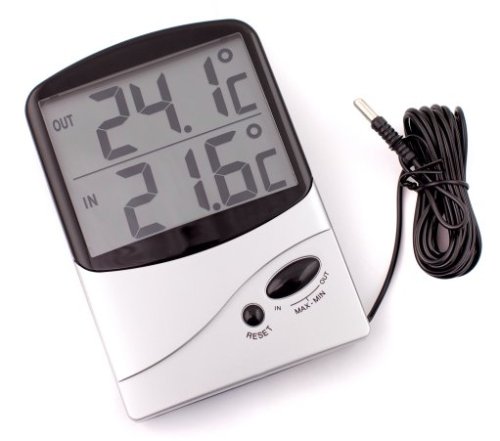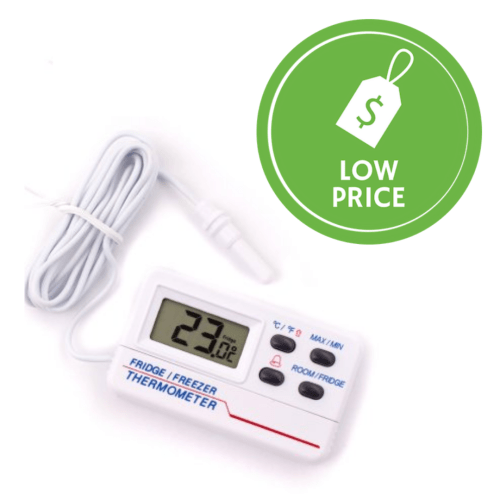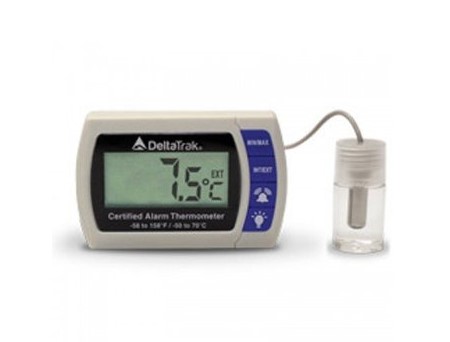Why use a fridge thermometer

Food safety is extremely important in the home and workplace. Unsafe food can create serious illness, and at worst, is a matter of life or death. What role can fridge thermometers play to reduce the risk of food spoilage and foodborne illness?
The Safe Food Zone
The safe food zone to reduce the risk of food spoilage and foodborne illnesses is above 60°c and below 5°c.
Whenever the topic of food safety arises, we often note the importance of cooking temperature, yet monitoring refrigeration temperature to ensure it is correct and consistent is just as important. Fridge thermometers are an easy, low-cost way to help you maintain ideal temperatures throughout your refrigerator.
This article addresses the reasons why you should be using a fridge thermometer, what to look for when choosing your device, and our team of scientists provides some excellent examples.
About Fridge Thermometers
Fridge thermometers are small devices used to measure the temperature of fridges and freezers during use. Designs cater for almost any situation, from basic temperature recording devices to fridge thermometers capable of very accurate measurements, that feature temperature alarms.
Factors Affecting Fridge Temperatures
- Ambient temperature: Clearly, higher ambient temperatures will test the cooling efficiency of a fridge or freezer.
- Door seals and fridge use: Opening and closing the doors will cause temperature fluctuations within a fridge or freezer environment.
- Fridge loading: A packed fridge will reduce the ability of the fridge to circulate cool air throughout the unit. Food Standards Australia and New Zealand (FSANZ) recommend removing any foods that are not potentially hazardous (e.g., soft drinks) and keeping them cool in insulated containers with ice or iceblocks.
- Fridge temperature zones: Fridge and freezers have warmer and cooler spots due to their cooling mechanisms and airflow. For example, the back and bottom walls tend to be cooler, while door shelves tend to be warmer by a few degrees.
How Fridge Thermometers Can Help
Fridge thermometers can give insight into the relative safety of fridges and freezers in the home, as well as throughout commercial food chain systems, over time. They measure whether constant and ideal temperatures are maintained. Where safe temperatures are not sustained, a fridge thermometer can provide vital insights into what corrective actions are required, and whether corrective actions have been successful.
Fridge thermometer designs vary widely to cater for a variety of applications. If you’re thinking of investing in a fridge thermometer, you need to compare alternative designs according to the following key criteria:
- MIN/MAX temperature - Storing MIN/MAX temperature recordings over time will help indicate whether temperatures have kept within safe food zones.
- Alarms – Some devices offer programmable or preset alarms that alert decision-makers whenever the fridge or freezer temperatures move outside safe food zones.
- External LCD – As previously mentioned, opening and closing fridge doors will cause temperature fluctuations — fridge thermometers with internal sensors and external screens aid in limiting excessive fridge access.
- Accuracy – Check that the accuracy of the device you seek matches your needs. FSANZ recommends a thermometer that is accurate to ±1°c.
Examples of Fridge Thermometers
Instrument Choice has chosen a few of the best examples of fridge thermometers. All have varying specifications and are suitable for either the home or the workplace.
Jumbo Display In-Out Thermometer 
Product Code: IC7310TM
Key features: This thermometer efficiently records and displays the current internal and external fridge temperature.
Applications: A suitable device for busy commercial environments with frequent fridge access.
Min/Max Temperature Recording: Yes
Alarms: No
External LCD: Yes
Accuracy: ±1°c
Digital Thermometer for Fridge or Freezer 
Product Code: KS-T-10S
Key features: A popular, reliable thermometer that records and displays the current internal and external fridge temperature. Its design incorporates a programmable alarm that is activated when fridge temperatures move outside your preset limits.
Applications: A suitable device for busy commercial environments with frequent fridge access.
Min/Max Temperature Recording: Yes
Alarms: Yes - Preset
External LCD: Yes
Accuracy: ±1°c
Certified Alarm Thermometer 
Product Code: IC-12215
Key features: This certified dual-channel alarm thermometer has internal and external sensors, minimum/maximum memory, a large, easy-to-read LCD screen, high/low alarm settings, and high-level accuracy.
The device is easy to use and supplied with a Manufacturer’s Certificate of Compliance that’s traceable to the National Institute of Standards and Technology (NIST).
Applications: A suitable device for food chain environments where health and safety compliance requirements include calibrated equipment.
Min/Max Temperature Recording: Yes
Alarms: Yes- User set
External LCD: Yes
Accuracy:±.0.5°C (from -10°C to 25°C), (±1.0°C above 25°C and below -10°C)
Conclusion
Using fridge thermometers is a simple and cost-effective way to ensure your home, work, and industrial coolrooms are maintaining a safe, constant internal temperature. By recording temperatures over time using a fridge thermometer to record temperature, you will remove the guesswork when setting your fridge temperature, and help avoid spoiled food and foodborne illnesses.
View the entire range of fridge specific thermometers on Instrument Choice here.
Do you have any questions about fridge thermometers? Want to know more about how to use them, how they work, or what best suits your application? Contact one of our helpful scientists on 1300 737 871 or email [email protected]. We’re here to help!
Also interesting
Poorly maintained, under-performing, or uncalibrated lab equipment will waste resources, time, and human resources. In many laboratories, a device reporting inconsistent, inaccurate, or out of specification results can have devastating consequences.
This article provides valuable tips on how best to keep your lab equipment performing reliably and accurately, including the calibration, maintenance, and replacement of devices – and, in doing so, you will follow good laboratory practice.

Fridge thermometers are affordable and easy to deploy instruments, which can help reduce the risk of foodborne illness while keeping food fresher for longer (win-win!). Fridge thermometers are valuable sensors in any fridge that stores food or beverages. The health, safety, quality, and financial benefits mean these devices should be considered for the home, and not exclusively for businesses or workplaces.
If you already have a fridge thermometer or searching for one to buy, but you are unsure of where to install it, read on to find out the ideal spot to ensure correct fridge temperature measurements, and a healthier fridge environment.

